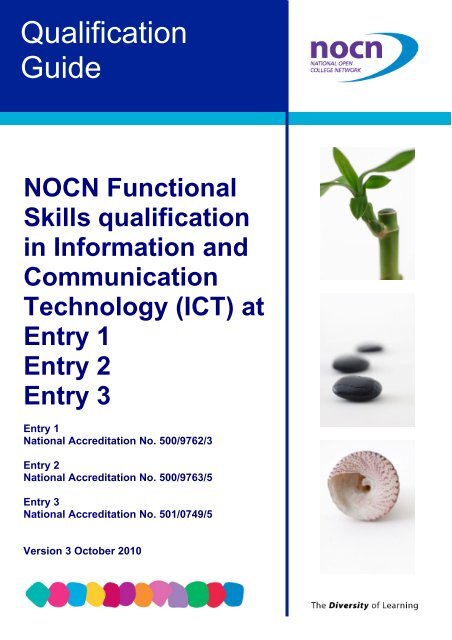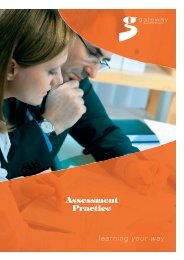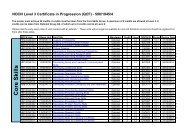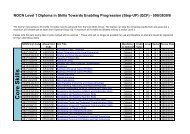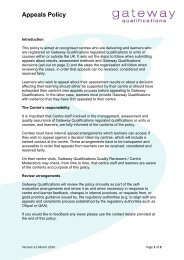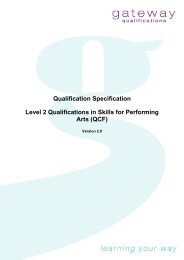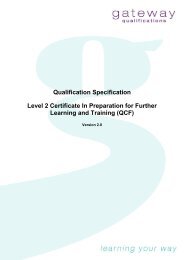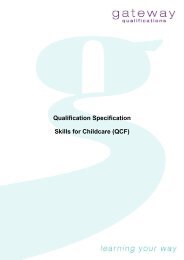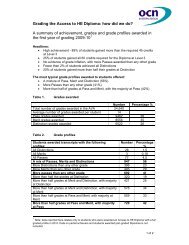NOCN Functional Skills qualification in Information and ...
NOCN Functional Skills qualification in Information and ...
NOCN Functional Skills qualification in Information and ...
- No tags were found...
You also want an ePaper? Increase the reach of your titles
YUMPU automatically turns print PDFs into web optimized ePapers that Google loves.
QualificationGuide<strong>NOCN</strong> <strong>Functional</strong><strong>Skills</strong> <strong>qualification</strong><strong>in</strong> <strong>Information</strong> <strong>and</strong>CommunicationTechnology (ICT) atEntry 1Entry 2Entry 3Entry 1National Accreditation No. 500/9762/3Entry 2National Accreditation No. 500/9763/5Entry 3National Accreditation No. 501/0749/5Version 3 October 20101
<strong>NOCN</strong> <strong>Functional</strong> <strong>Skills</strong> <strong>qualification</strong> <strong>in</strong> <strong>Information</strong><strong>and</strong> Communication Technology (ICT) at Entry 1<strong>NOCN</strong> <strong>Functional</strong> <strong>Skills</strong> <strong>qualification</strong> <strong>in</strong> <strong>Information</strong><strong>and</strong> Communication Technology (ICT) at Entry 2<strong>NOCN</strong> <strong>Functional</strong> <strong>Skills</strong> <strong>qualification</strong> <strong>in</strong> <strong>Information</strong><strong>and</strong> Communication Technology (ICT) at Entry 3National Open College NetworkThe National Open College Network (<strong>NOCN</strong>) is the lead<strong>in</strong>g credit <strong>and</strong> unit based Award<strong>in</strong>gBody <strong>in</strong> the UK. <strong>NOCN</strong> provides a national framework of credit-based units <strong>and</strong> <strong>qualification</strong>swhich are underp<strong>in</strong>ned by a range of national <strong>and</strong> local services, <strong>in</strong>clud<strong>in</strong>g curriculum support<strong>and</strong> staff development.<strong>NOCN</strong>, through its Open College Networks (OCNs), works with over 3,000 centres across theUK to develop flexible <strong>and</strong> responsive credit based awards <strong>and</strong> <strong>qualification</strong>s that widen accessto lifelong learn<strong>in</strong>g <strong>and</strong> address exclusion, participation <strong>and</strong> achievement. The structure of our<strong>qualification</strong>s provides opportunities for learners to achieve unit credits <strong>and</strong> use these to ga<strong>in</strong>access to full <strong>qualification</strong>s <strong>and</strong> further learn<strong>in</strong>g.Quality assurance, supported at the po<strong>in</strong>t of delivery, underp<strong>in</strong>s all <strong>NOCN</strong> credit achievement<strong>and</strong> <strong>qualification</strong>s. OCNs approve centres that can demonstrate the ability to meet nationalrequirements for course delivery <strong>and</strong> quality assurance to support credit awards <strong>and</strong><strong>qualification</strong>s. OCNs have wide-rang<strong>in</strong>g experience <strong>in</strong> centre <strong>and</strong> programme approval <strong>and</strong>support centres to ensure all awards are valid <strong>and</strong> valued.<strong>Functional</strong> <strong>Skills</strong> <strong>qualification</strong>s <strong>in</strong> English, mathematics <strong>and</strong> <strong>Information</strong> <strong>and</strong> CommunicationTechnology (ICT) have been developed <strong>and</strong> accredited as part of the QCDA-led <strong>Functional</strong><strong>Skills</strong> <strong>qualification</strong>s pilot. <strong>Functional</strong> <strong>Skills</strong> are the practical skills <strong>in</strong> English, mathematics <strong>and</strong><strong>Information</strong> <strong>and</strong> Communication Technology (ICT) that allow <strong>in</strong>dividuals to work confidently,effectively <strong>and</strong> <strong>in</strong>dependently <strong>in</strong> life. Follow<strong>in</strong>g <strong>in</strong>itial research <strong>and</strong> trials, a three year pilot ofthese <strong>qualification</strong>s took place between September 2007 <strong>and</strong> August 2010. As part of thisproject, <strong>NOCN</strong> has developed <strong>qualification</strong>s <strong>in</strong> English, mathematics <strong>and</strong> ICT at Entry Level <strong>and</strong>Levels 1 <strong>and</strong> 2, which have been piloted, evaluated <strong>and</strong> developed further over this three yearperiod.The <strong>NOCN</strong> <strong>Functional</strong> <strong>Skills</strong> <strong>qualification</strong> <strong>in</strong> <strong>Information</strong> <strong>and</strong> Communication Technology (ICT)at Entry 1, Entry 2 <strong>and</strong> Entry 3 are <strong>qualification</strong>s developed under the QCDA <strong>Functional</strong> <strong>Skills</strong>programme, which is available <strong>in</strong> Engl<strong>and</strong> only. The <strong>qualification</strong>s are designed to develop <strong>and</strong>assess <strong>Functional</strong> <strong>Skills</strong> at Entry Level as determ<strong>in</strong>ed by the <strong>Functional</strong> <strong>Skills</strong> criteria. The<strong>qualification</strong>s are available to centres across a range of contexts, <strong>in</strong>clud<strong>in</strong>g further education,adult <strong>and</strong> community learn<strong>in</strong>g, schools <strong>and</strong> the justice system. For further <strong>in</strong>formation onbecom<strong>in</strong>g a <strong>Functional</strong> <strong>Skills</strong> centre please contact your OCN.2
<strong>NOCN</strong> <strong>Functional</strong> <strong>Skills</strong> <strong>qualification</strong> <strong>in</strong> <strong>Information</strong><strong>and</strong> Communication Technology (ICT) at Entry 1<strong>NOCN</strong> <strong>Functional</strong> <strong>Skills</strong> <strong>qualification</strong> <strong>in</strong> <strong>Information</strong><strong>and</strong> Communication Technology (ICT) at Entry 2<strong>NOCN</strong> <strong>Functional</strong> <strong>Skills</strong> <strong>qualification</strong> <strong>in</strong> <strong>Information</strong><strong>and</strong> Communication Technology (ICT) at Entry 3Contents1. About the <strong>Functional</strong> <strong>Skills</strong> <strong>qualification</strong>s ..................................................... 42. <strong>NOCN</strong> <strong>Functional</strong> <strong>Skills</strong> <strong>qualification</strong> <strong>in</strong> <strong>Information</strong> <strong>and</strong> CommunicationTechnology (ICT) at Entry 1, Entry 2 <strong>and</strong> Entry 3 ........................................ 73. Who are the <strong>qualification</strong>s for ..................................................................... 104. Achiev<strong>in</strong>g the <strong>qualification</strong>s ........................................................................ 135. How the <strong>qualification</strong>s be assessed ........................................................... 156. Offer<strong>in</strong>g the <strong>qualification</strong>s ........................................................................... 187. How are the <strong>qualification</strong>s is quality assured ............................................. 22AppendicesAppendix 1 <strong>Functional</strong> <strong>Skills</strong> Criteria: <strong>Information</strong> <strong>and</strong> CommunicationTechnology (ICT)Appendix 2 Observation of Internal Assessment Record SheetAppendix 3 Nom<strong>in</strong>ation Form for Approved Lead Assessor Role3
<strong>NOCN</strong> <strong>Functional</strong> <strong>Skills</strong> <strong>qualification</strong> <strong>in</strong> <strong>Information</strong><strong>and</strong> Communication Technology (ICT) at Entry 1<strong>NOCN</strong> <strong>Functional</strong> <strong>Skills</strong> <strong>qualification</strong> <strong>in</strong> <strong>Information</strong><strong>and</strong> Communication Technology (ICT) at Entry 2<strong>NOCN</strong> <strong>Functional</strong> <strong>Skills</strong> <strong>qualification</strong> <strong>in</strong> <strong>Information</strong><strong>and</strong> Communication Technology (ICT) at Entry 31. About the <strong>Functional</strong> <strong>Skills</strong> <strong>qualification</strong>sIntroduction to <strong>Functional</strong> <strong>Skills</strong><strong>Functional</strong> <strong>Skills</strong> are practical skills <strong>in</strong> English, mathematics <strong>and</strong> <strong>Information</strong> <strong>and</strong>Communication Technology (ICT). They are def<strong>in</strong>ed as:….practical skills <strong>in</strong> English, mathematics <strong>and</strong> <strong>Information</strong> <strong>and</strong> Communication Technology(ICT) that allow <strong>in</strong>dividuals to operate confidently, effectively <strong>and</strong> <strong>in</strong>dependently <strong>in</strong> everyday life,<strong>in</strong>clud<strong>in</strong>g <strong>in</strong> the workplace. 1Development of <strong>Functional</strong> <strong>Skills</strong>Follow<strong>in</strong>g the 14-19 Education <strong>and</strong> <strong>Skills</strong> White Paper (February 2005) <strong>and</strong> the <strong>Skills</strong> WhitePaper (March 2005), the DfES gave QDCA a remit to develop <strong>Functional</strong> <strong>Skills</strong> <strong>in</strong> English,mathematics <strong>and</strong> ICT.Employers <strong>and</strong> educators have identified these skills as vital for enabl<strong>in</strong>g young people <strong>and</strong>adults to have the practical skills to succeed <strong>in</strong> further learn<strong>in</strong>g, employment <strong>and</strong> life <strong>in</strong> modernsociety.In 2006 the FE Reform White Paper: Rais<strong>in</strong>g <strong>Skills</strong>, Improv<strong>in</strong>g Life Chances built on the exist<strong>in</strong>g14-19 Education <strong>and</strong> <strong>Skills</strong> White Paper <strong>and</strong> the <strong>Skills</strong> Strategy to set out a series of reformswhich will raise skills <strong>and</strong> <strong>qualification</strong> levels for young people <strong>and</strong> adults to world st<strong>and</strong>ards.These reforms, <strong>in</strong>clud<strong>in</strong>g the <strong>in</strong>troduction of <strong>Functional</strong> <strong>Skills</strong> <strong>qualification</strong>s, will all contribute toaddress<strong>in</strong>g the skills shortages identified <strong>in</strong> the 2006 Leitch Review of <strong>Skills</strong>: Prosperity for all <strong>in</strong>the global economy – world class skills. The Government response to this is <strong>in</strong>cluded <strong>in</strong> WorldClass <strong>Skills</strong>: Implement<strong>in</strong>g the Leitch Review of <strong>Skills</strong> <strong>in</strong> Engl<strong>and</strong>.To ensure that <strong>Functional</strong> <strong>Skills</strong> are readily accessible to the full range of learners, they will beavailable as an <strong>in</strong>tegral part of the new Diplomas, Foundation Learn<strong>in</strong>g <strong>and</strong> Apprenticeships.The <strong>qualification</strong>s have been designed to be suitable, therefore, for a wide range of c<strong>and</strong>idates,from young people <strong>in</strong>volved <strong>in</strong> GCSEs <strong>in</strong> schools to adults <strong>in</strong>volved <strong>in</strong> learn<strong>in</strong>g programmes tohelp them f<strong>in</strong>d <strong>and</strong> progress <strong>in</strong> work.1 QCDA http://www.qcda.org.uk/functionalskills4
<strong>NOCN</strong> <strong>Functional</strong> <strong>Skills</strong> <strong>qualification</strong> <strong>in</strong> <strong>Information</strong><strong>and</strong> Communication Technology (ICT) at Entry 1<strong>NOCN</strong> <strong>Functional</strong> <strong>Skills</strong> <strong>qualification</strong> <strong>in</strong> <strong>Information</strong><strong>and</strong> Communication Technology (ICT) at Entry 2<strong>NOCN</strong> <strong>Functional</strong> <strong>Skills</strong> <strong>qualification</strong> <strong>in</strong> <strong>Information</strong><strong>and</strong> Communication Technology (ICT) at Entry 3<strong>Functional</strong> <strong>Skills</strong> CriteriaWork<strong>in</strong>g with a wide range of partners, QCDA produced f<strong>in</strong>al versions of the <strong>Functional</strong> <strong>Skills</strong>criteria. These were published <strong>in</strong> November 2009. <strong>Functional</strong> <strong>Skills</strong> criteria are available forEnglish, mathematics <strong>and</strong> ICT at Entry 1, Entry 2, Entry 3, Level 1 <strong>and</strong> Level 2. The criteriadeterm<strong>in</strong>e the knowledge <strong>and</strong> skills proficiency required by learners at each level.The <strong>Functional</strong> <strong>Skills</strong> criteria are designed to provide a framework for assessment <strong>and</strong> to besufficiently flexible to be <strong>in</strong>terpreted <strong>in</strong> a variety of contexts, for example <strong>in</strong> school <strong>and</strong>workplace sett<strong>in</strong>gs, <strong>and</strong> by a range of users.The <strong>Functional</strong> <strong>Skills</strong> criteria can be found on QCDA’s website www.qcda.org.uk/functionalskills.<strong>Functional</strong> <strong>Skills</strong> Assessments<strong>Functional</strong> <strong>Skills</strong> assessments are based primarily on task-based scenario questions with alimited duration. The <strong>qualification</strong>s at each sub-level of Entry Level are <strong>in</strong>ternally assessedunder controlled assessment conditions through a s<strong>in</strong>gle component assessment consist<strong>in</strong>g of anumber of short tasks. The assessments will use <strong>and</strong> re<strong>in</strong>force skills-based, problem-solv<strong>in</strong>glearn<strong>in</strong>g techniques. Assessment opportunities will be offered throughout the year, on dem<strong>and</strong>so that learners may access the assessments when their tutors feel they are ready. Learnersmay complete the assessments task by task with short breaks <strong>in</strong> between, provided that theshort assessment sessions do not total more than the permitted duration of the assessment <strong>and</strong>that learners cannot access the assessments or further teach<strong>in</strong>g between the sessions.Centres may download the assessments from the secure <strong>Functional</strong> <strong>Skills</strong> section of the <strong>NOCN</strong>website (www.nocn.org.uk). Centres should contact functionalskills@nocn.org.uk if they do nothave a <strong>Functional</strong> <strong>Skills</strong> log<strong>in</strong> for the site. The assessments may be contextualised by the centreus<strong>in</strong>g the guidance on the assessment mark sheet. A copy of the contextualised assessmentshould be made available to <strong>NOCN</strong> or the regional quality reviewer on request. If a centredecides to design a totally new assessment, they should submit it to <strong>NOCN</strong> at least 15 work<strong>in</strong>gdays before the planned use of the assessment with learners to allow the assessment to best<strong>and</strong>ardised <strong>in</strong> the same way as other <strong>NOCN</strong> devised assessments. When <strong>NOCN</strong> is satisfiedthat the assessment meets the criteria, the centre will receive confirmation that it approved. Thecentre must give permission for the assessment to be added to the assessment bank availableto all other centres.A m<strong>in</strong>imum of 10% of assessments at Entry 1 must be observed by an experienced <strong>in</strong>ternalverifier alongside the <strong>Functional</strong> <strong>Skills</strong> ICT tutor to check that the assessment is tak<strong>in</strong>g placewith<strong>in</strong> the <strong>NOCN</strong> guidel<strong>in</strong>es <strong>and</strong> to verify the assessment decisions. A written record must bemade of the observation. An exemplar Observation of Internal Assessment Record Sheet maybe found <strong>in</strong> Appendix 2 which identifies the m<strong>in</strong>imum <strong>in</strong>formation required, but centres maydevelop their own record<strong>in</strong>g sheet as long as it captures the m<strong>in</strong>imum <strong>in</strong>formation required by5
<strong>NOCN</strong> <strong>Functional</strong> <strong>Skills</strong> <strong>qualification</strong> <strong>in</strong> <strong>Information</strong><strong>and</strong> Communication Technology (ICT) at Entry 1<strong>NOCN</strong> <strong>Functional</strong> <strong>Skills</strong> <strong>qualification</strong> <strong>in</strong> <strong>Information</strong><strong>and</strong> Communication Technology (ICT) at Entry 2<strong>NOCN</strong> <strong>Functional</strong> <strong>Skills</strong> <strong>qualification</strong> <strong>in</strong> <strong>Information</strong><strong>and</strong> Communication Technology (ICT) at Entry 3<strong>NOCN</strong>. Once the assessment records are completed by the assessor, the centre shouldcomplete an <strong>in</strong>ternal verification sample of the documents.A quality reviewer will visit the centre to check the quality of the assessment <strong>and</strong> verificationsystems. See section 7 for further details of quality systems.The <strong>NOCN</strong> <strong>Functional</strong> <strong>Skills</strong> <strong>qualification</strong> <strong>in</strong> <strong>Information</strong> <strong>and</strong> Communication Technology (ICT)at Entry 1, Entry 2 <strong>and</strong> Entry 3 <strong>qualification</strong>s comprise of one s<strong>in</strong>gle summative assessmentwhich focuses on the three <strong>in</strong>terrelated skill areas of us<strong>in</strong>g ICT, f<strong>in</strong>d<strong>in</strong>g <strong>and</strong> select<strong>in</strong>g <strong>Information</strong><strong>and</strong> develop<strong>in</strong>g, present<strong>in</strong>g <strong>and</strong> communicat<strong>in</strong>g <strong>in</strong>formation. The assessments conta<strong>in</strong> anumber of tasks which cover the whole of the criteria <strong>and</strong> sample from the coverage <strong>and</strong> rangestatements at this level, <strong>and</strong> also sampl<strong>in</strong>g from the range of contexts. 20-30% of marks areallocated to us<strong>in</strong>g ICT, 10-20% of marks are allocated to f<strong>in</strong>d<strong>in</strong>g <strong>and</strong> select<strong>in</strong>g <strong>in</strong>formation <strong>and</strong>50-70% of marks are allocated to develop<strong>in</strong>g, present<strong>in</strong>g <strong>and</strong> communicat<strong>in</strong>g <strong>in</strong>formation. Allassessments, regardless of the sample, will cover all three skill areas. Each assessment willcover a m<strong>in</strong>imum of 60% of the coverage <strong>and</strong> range statements <strong>and</strong> across four different liveassessments, the whole of the coverage <strong>and</strong> range statements will be evidenced at least twice.Entry 1 <strong>and</strong> Entry 2 assessments are one hour <strong>in</strong> duration. Entry 3 assessments are one <strong>and</strong> ahalf hours <strong>in</strong> duration.All tasks must be completed. All assessments are <strong>in</strong>ternally assessed <strong>and</strong> centres may useeither the <strong>NOCN</strong> devised assessment or contextualise the assessment <strong>in</strong> l<strong>in</strong>e with the guidance<strong>in</strong> the assessment mark scheme. Each assessment has detailed guidel<strong>in</strong>es which outl<strong>in</strong>es howthe assessment must adm<strong>in</strong>istered <strong>and</strong> the level <strong>and</strong> type of support available to the learners<strong>and</strong> a detailed mark scheme identifies how marks should be allocated by assessors.6
<strong>NOCN</strong> <strong>Functional</strong> <strong>Skills</strong> <strong>qualification</strong> <strong>in</strong> <strong>Information</strong><strong>and</strong> Communication Technology (ICT) at Entry 1<strong>NOCN</strong> <strong>Functional</strong> <strong>Skills</strong> <strong>qualification</strong> <strong>in</strong> <strong>Information</strong><strong>and</strong> Communication Technology (ICT) at Entry 2<strong>NOCN</strong> <strong>Functional</strong> <strong>Skills</strong> <strong>qualification</strong> <strong>in</strong> <strong>Information</strong><strong>and</strong> Communication Technology (ICT) at Entry 32. <strong>NOCN</strong> <strong>Functional</strong> <strong>Skills</strong> <strong>qualification</strong> <strong>in</strong> <strong>Information</strong> <strong>and</strong> CommunicationTechnology (ICT) at Entry 1, Entry 2 <strong>and</strong> Entry 3Aims <strong>and</strong> Objectives of the QualificationsThe term functional should be considered <strong>in</strong> the broad sense of provid<strong>in</strong>g learners with the skills<strong>and</strong> abilities they need to take an active <strong>and</strong> responsible role <strong>in</strong> their communities, <strong>in</strong> theirworkplace <strong>and</strong> <strong>in</strong> educational sett<strong>in</strong>gs. It requires learners to be able to communicate <strong>in</strong> waysthat make them effective <strong>and</strong> <strong>in</strong>volved as citizens, operate confidently <strong>and</strong> to convey their ideas<strong>and</strong> op<strong>in</strong>ions clearly <strong>in</strong> a wide range of contexts.The <strong>Functional</strong> <strong>Skills</strong> criteria <strong>in</strong> <strong>Information</strong> <strong>and</strong> Communication Technology (ICT) aim to equiplearners with the skills <strong>and</strong> confidence to apply, comb<strong>in</strong>e <strong>and</strong> adapt their ICT knowledge <strong>and</strong>problem solv<strong>in</strong>g skills to new situations <strong>in</strong> their life <strong>and</strong> work <strong>in</strong> a range of contexts <strong>and</strong> forvarious purposes.The aim of the <strong>Functional</strong> <strong>Skills</strong> <strong>in</strong> <strong>Information</strong> <strong>and</strong> Communication Technology (ICT)<strong>qualification</strong>s are therefore to equip learners with the skills <strong>and</strong> confidence to apply, comb<strong>in</strong>e<strong>and</strong> adapt their ICT knowledge to new situations <strong>in</strong> their life <strong>and</strong> work. They are concerned withdevelop<strong>in</strong>g <strong>and</strong> recognis<strong>in</strong>g the ability of learners to apply <strong>and</strong> transfer skills <strong>in</strong> ways that areappropriate to their situation. The assessments therefore focus on functionality <strong>and</strong> theapplication of skills as articulated by the <strong>Functional</strong> <strong>Skills</strong> criteria <strong>in</strong> <strong>Information</strong> <strong>and</strong>Communication Technology (ICT).The <strong>NOCN</strong> <strong>Functional</strong> <strong>Skills</strong> <strong>qualification</strong> <strong>in</strong> <strong>Information</strong> <strong>and</strong> Communication Technology (ICT)at Entry 1, Entry 2 <strong>and</strong> Entry 3 <strong>qualification</strong>s are designed to assess <strong>Functional</strong> <strong>Skills</strong> <strong>in</strong> ICT ateach sub-level of Entry Level as determ<strong>in</strong>ed by the <strong>Functional</strong> <strong>Skills</strong> criteria. The <strong>qualification</strong>srequire learners to successfully achieve summative assessment tasks that are externally set.C<strong>and</strong>idates can take these when they have undergone a relevant teach<strong>in</strong>g <strong>and</strong> learn<strong>in</strong>gprogramme that covers the functional <strong>Information</strong> <strong>and</strong> Communication Technology criteria <strong>in</strong>their entirety at the relevant sub-level of Entry Level <strong>and</strong> have developed the appropriate skillsready for assessment.Subject Matter <strong>and</strong> Content of the QualificationsTo achieve the <strong>NOCN</strong> <strong>Functional</strong> <strong>Skills</strong> <strong>qualification</strong> <strong>in</strong> <strong>Information</strong> <strong>and</strong> CommunicationTechnology (ICT) at Entry 1, Entry 2 <strong>and</strong> Entry 3 <strong>qualification</strong>s learners would be expected to:• Apply their knowledge <strong>and</strong> underst<strong>and</strong><strong>in</strong>g to identify the ICT requirements to produce anappropriate solution to practical problems (complexity).• Apply a range of techniques across an <strong>in</strong>creas<strong>in</strong>gly wide range of situations <strong>and</strong>contexts to generate successful outcomes (technical dem<strong>and</strong>).• Use ICT skills with <strong>in</strong>creas<strong>in</strong>g levels of <strong>in</strong>dependence, draw<strong>in</strong>g on a range of approachesto obta<strong>in</strong> answers to problems (<strong>in</strong>dependence).• Apply their knowledge, skills <strong>and</strong> underst<strong>and</strong><strong>in</strong>g with<strong>in</strong> familiar contexts (familiarity).7
<strong>NOCN</strong> <strong>Functional</strong> <strong>Skills</strong> <strong>qualification</strong> <strong>in</strong> <strong>Information</strong><strong>and</strong> Communication Technology (ICT) at Entry 1<strong>NOCN</strong> <strong>Functional</strong> <strong>Skills</strong> <strong>qualification</strong> <strong>in</strong> <strong>Information</strong><strong>and</strong> Communication Technology (ICT) at Entry 2<strong>NOCN</strong> <strong>Functional</strong> <strong>Skills</strong> <strong>qualification</strong> <strong>in</strong> <strong>Information</strong><strong>and</strong> Communication Technology (ICT) at Entry 3There are no units of assessment with<strong>in</strong> the <strong>Functional</strong> <strong>Skills</strong> <strong>qualification</strong>s, which are achievedby successful completion of externally set summative assessments. All learners must completesome element of the assessment <strong>and</strong> cannot, therefore, be exempt from the entire assessmentfor a <strong>qualification</strong>. There can be no exemptions from <strong>Functional</strong> <strong>Skills</strong> ICT <strong>and</strong> mathematics asthese are <strong>in</strong>tegrated, s<strong>in</strong>gle component <strong>qualification</strong>s.Adm<strong>in</strong>istrative guidance may be found <strong>in</strong> the Centre Guidance for <strong>Functional</strong> <strong>Skills</strong> document.Assessments focus on functional real-life situations. They assess the effective application ofICT skills <strong>in</strong> purposeful familiar contexts <strong>and</strong> straightforward scenarios at each sub-level of ICT.They assess how learners approach familiar tasks <strong>in</strong> a range of contexts <strong>and</strong> straightforwardsituations, us<strong>in</strong>g a range of techniques to identify solutions to practical problems. Assessmentsare developed around a broad theme, for example, Gett<strong>in</strong>g Fit.Guided Learn<strong>in</strong>g HoursThe total recommended guided learn<strong>in</strong>g hours for all <strong>qualification</strong>s are 45 hours.Relationship with National St<strong>and</strong>ardsThe <strong>NOCN</strong> <strong>Functional</strong> <strong>Skills</strong> <strong>qualification</strong> <strong>in</strong> <strong>Information</strong> <strong>and</strong> Communication Technology (ICT)at Entry 1, Entry 2 <strong>and</strong> Entry 3 are <strong>qualification</strong>s related to the <strong>Functional</strong> Criteria: <strong>Information</strong><strong>and</strong> Communication Technology (ICT) November 2009 developed by QCDA. They assessunderst<strong>and</strong><strong>in</strong>g <strong>and</strong> skills development that underp<strong>in</strong>s functional competence <strong>in</strong> ICT as identified<strong>in</strong> these criteria. The <strong>Functional</strong> <strong>Skills</strong> criteria for <strong>Information</strong> <strong>and</strong> Communication Technology(ICT) Entry Level 1, Entry 2 <strong>and</strong> Entry 3 can be found <strong>in</strong> Appendix 1.Relationship with Key <strong>Skills</strong> <strong>and</strong> ICT <strong>Skills</strong> for Life QualificationsKey skills <strong>and</strong> ICT <strong>Skills</strong> for Life <strong>qualification</strong>s are accredited until August 2010, with certificationend dates of August 2012.Part of the evaluation of the <strong>Functional</strong> <strong>Skills</strong> pilot will look at the relationship between<strong>Functional</strong> <strong>Skills</strong> <strong>and</strong> key <strong>and</strong> basic skills.Language RequirementsThe <strong>Functional</strong> <strong>Skills</strong> <strong>qualification</strong>s are only available <strong>in</strong> Engl<strong>and</strong> <strong>and</strong> therefore these<strong>qualification</strong>s are only available <strong>in</strong> English.8
<strong>NOCN</strong> <strong>Functional</strong> <strong>Skills</strong> <strong>qualification</strong> <strong>in</strong> <strong>Information</strong><strong>and</strong> Communication Technology (ICT) at Entry 1<strong>NOCN</strong> <strong>Functional</strong> <strong>Skills</strong> <strong>qualification</strong> <strong>in</strong> <strong>Information</strong><strong>and</strong> Communication Technology (ICT) at Entry 2<strong>NOCN</strong> <strong>Functional</strong> <strong>Skills</strong> <strong>qualification</strong> <strong>in</strong> <strong>Information</strong><strong>and</strong> Communication Technology (ICT) at Entry 33. Who are the <strong>qualification</strong>s forThere are no age restrictions for these <strong>qualification</strong>s.<strong>Functional</strong> <strong>Skills</strong> are vital to the personal development of all learners.The <strong>qualification</strong> is suitable for a wide range of c<strong>and</strong>idates <strong>in</strong>clud<strong>in</strong>g:• adults <strong>in</strong>volved <strong>in</strong> learn<strong>in</strong>g programmes to prepare them for work;• adults <strong>in</strong> work to provide progression opportunities;• young people <strong>in</strong>volved <strong>in</strong> GCSEs <strong>in</strong> schools;• those <strong>in</strong>volved <strong>in</strong> Diplomas <strong>and</strong> Apprenticeships.These new <strong>qualification</strong>s are assessed primarily through tasks, rather than traditionalknowledge-based tests, help<strong>in</strong>g learners to enhance <strong>and</strong> apply their problem solv<strong>in</strong>g skillseffectively.Adults <strong>and</strong> young people will develop vital problem-solv<strong>in</strong>g skills, ensur<strong>in</strong>g that they are wellequipped for success <strong>in</strong> employment, further learn<strong>in</strong>g <strong>and</strong> life.Employers will also benefit as <strong>Functional</strong> <strong>Skills</strong> <strong>qualification</strong>s will help to ensure that employeesare able to apply fundamental problem-solv<strong>in</strong>g skills <strong>in</strong> work situations, improv<strong>in</strong>g effectiveness<strong>and</strong> productivity.<strong>Functional</strong> <strong>Skills</strong> Assessments<strong>Functional</strong> <strong>Skills</strong> assessments are designed:• As summative assessments, for example they can be used when the learner is ready forassessment, that is, they have developed the appropriate skills through a teach<strong>in</strong>g <strong>and</strong>learn<strong>in</strong>g programme. This should cover the <strong>Functional</strong> <strong>Skills</strong> criteria <strong>in</strong> their entirety atthe relevant sub-level of Entry Level.• To assess the whole of the <strong>Functional</strong> <strong>Skills</strong> criteria <strong>and</strong> a sample of the coverage <strong>and</strong>range statements.• To assess confident <strong>and</strong> competent use of the three <strong>in</strong>terrelated skills of us<strong>in</strong>g ICT,f<strong>in</strong>d<strong>in</strong>g <strong>and</strong> select<strong>in</strong>g <strong>in</strong>formation <strong>and</strong> develop<strong>in</strong>g, present<strong>in</strong>g <strong>and</strong> communicat<strong>in</strong>g<strong>in</strong>formationThe assessments will be externally developed by <strong>NOCN</strong> <strong>and</strong> will be designed as assessmenttasks based on ‘real life’ contexts. Contexts may be based on for example:• Work <strong>and</strong> education.• Community, citizenship <strong>and</strong> environment.• Family, home <strong>and</strong> social issues.10
<strong>NOCN</strong> <strong>Functional</strong> <strong>Skills</strong> <strong>qualification</strong> <strong>in</strong> <strong>Information</strong><strong>and</strong> Communication Technology (ICT) at Entry 1<strong>NOCN</strong> <strong>Functional</strong> <strong>Skills</strong> <strong>qualification</strong> <strong>in</strong> <strong>Information</strong><strong>and</strong> Communication Technology (ICT) at Entry 2<strong>NOCN</strong> <strong>Functional</strong> <strong>Skills</strong> <strong>qualification</strong> <strong>in</strong> <strong>Information</strong><strong>and</strong> Communication Technology (ICT) at Entry 3All assessments at Entry 1, Entry 2 <strong>and</strong> Entry 3 are <strong>in</strong>ternally assessed <strong>and</strong> externally verified<strong>and</strong> the assessments should take place under controlled conditions. These assessments aredownloaded from www.nocn.org.uk with a secure <strong>Functional</strong> <strong>Skills</strong> log<strong>in</strong> <strong>and</strong> may becontextualised by the centre <strong>in</strong> l<strong>in</strong>e with the guidance available on the assessment mark sheetor centres may use the <strong>NOCN</strong> devised assessments. Further guidance on the controlledassessment may be found <strong>in</strong> the Centre Guidance for <strong>Functional</strong> <strong>Skills</strong> document, with<strong>in</strong> theassessment mark sheet or <strong>in</strong> section 1 of this <strong>qualification</strong> guide.Restrictions on Learner EntryThere are no restrictions on learner entry to these <strong>qualification</strong>s. However learners should haveundertaken relevant <strong>in</strong>itial assessments to ensure that they are follow<strong>in</strong>g an appropriate learn<strong>in</strong>gprogramme lead<strong>in</strong>g to the summative assessment.Recommended Prior Learn<strong>in</strong>gThere is no recommended prior knowledge, atta<strong>in</strong>ment or experience needed by learnerswish<strong>in</strong>g to enrol on these <strong>qualification</strong>s.Learners with Particular RequirementsAssessment with<strong>in</strong> the <strong>NOCN</strong> <strong>Functional</strong> <strong>Skills</strong> <strong>qualification</strong> <strong>in</strong> <strong>Information</strong> <strong>and</strong> CommunicationTechnology (ICT) at Entry 1, Entry 2 <strong>and</strong> Entry 3 is designed to be accessible <strong>and</strong> <strong>in</strong>clusive.The assessment methodology is appropriate <strong>and</strong> rigorous for <strong>in</strong>dividuals or groups of learners.If you have learners with particular requirements you should refer to the ‘Access to FairAssessment Policy <strong>and</strong> Procedure’ which can be found <strong>in</strong> the <strong>NOCN</strong> Centre H<strong>and</strong>book area ofthe <strong>NOCN</strong> website with<strong>in</strong> the Learn<strong>in</strong>g Providers section.This section gives clear guidance on the reasonable adjustments <strong>and</strong> arrangements that can bemade to take account of disability or learn<strong>in</strong>g difficulty without compris<strong>in</strong>g the achievement ofthe assessment criteria.The <strong>NOCN</strong> Centre Recognition process requires policy statements on Equal Opportunities <strong>and</strong>Diversity <strong>and</strong> Disability Discrim<strong>in</strong>ation. These policy statements are then checked <strong>and</strong>confirmed through the Quality Review <strong>and</strong> Risk Assessment processes.In addition, the <strong>Functional</strong> <strong>Skills</strong> <strong>Information</strong> <strong>and</strong> Communication Technology (ICT) criteriaoutl<strong>in</strong>e additional support which may be made available to the learners (see the next page fordetails).11
<strong>NOCN</strong> <strong>Functional</strong> <strong>Skills</strong> <strong>qualification</strong> <strong>in</strong> <strong>Information</strong><strong>and</strong> Communication Technology (ICT) at Entry 1<strong>NOCN</strong> <strong>Functional</strong> <strong>Skills</strong> <strong>qualification</strong> <strong>in</strong> <strong>Information</strong><strong>and</strong> Communication Technology (ICT) at Entry 2<strong>NOCN</strong> <strong>Functional</strong> <strong>Skills</strong> <strong>qualification</strong> <strong>in</strong> <strong>Information</strong><strong>and</strong> Communication Technology (ICT) at Entry 3In complet<strong>in</strong>g assessment lead<strong>in</strong>g to <strong>Functional</strong> <strong>Skills</strong> ICT <strong>qualification</strong>s, c<strong>and</strong>idates can haveaccess to all forms of equipment <strong>and</strong> software that constitute their normal way of work<strong>in</strong>g,provided that these do not affect the reliability or validity of assessment outcomes or give thelearner an assessment advantage over other learners undertak<strong>in</strong>g the same or similarassessments.The <strong>Functional</strong> <strong>Skills</strong> <strong>qualification</strong>s criteria require award<strong>in</strong>g organisations to developassessment materials that anticipate the needs of disabled learners <strong>and</strong> which m<strong>in</strong>imise, as faras possible, the need to make reasonable adjustments (whilst still assess<strong>in</strong>g the skills criteria)or exemptions.For details of access arrangements <strong>and</strong> reasonable adjustments for <strong>Functional</strong> <strong>Skills</strong> ICT<strong>qualification</strong>, please see the JCQ publication ‘Access Arrangements, Reasonable Adjustments<strong>and</strong> Special Consideration, General <strong>and</strong> Vocational Qualifications’.The table below summarises arrangements to which c<strong>and</strong>idates can have access <strong>in</strong> meet<strong>in</strong>g therequirements of <strong>Functional</strong> <strong>Skills</strong> ICT <strong>qualification</strong>s.Does the assessment allow the use of these access arrangements?Access arrangements Yes/No Type of assessmentReader/screen reader YesScribesYesPractical Assistants Yes For assessment of the application of skillsdescribed by the criteria, a practicalassistant may switch on the computer<strong>and</strong> <strong>in</strong>sert a disk at the c<strong>and</strong>idate’s<strong>in</strong>struction but must not perform any skillfor which marks are credited. (For moredetail please see commentary aga<strong>in</strong>st<strong>in</strong>dividual skills criteria) Assistants canbe used <strong>in</strong> written assessments.Word ProcessorsYesTranscriptsYesBSL <strong>in</strong>terpretersYesOral language modifiers YesModified question papers Yes(<strong>in</strong>clud<strong>in</strong>g Braille)Extra TimeYesExternal device to loadpersonal sett<strong>in</strong>gsYes Permitted as a reasonable adjustmentprovided this does not compromise theassessment or give the c<strong>and</strong>idate anyadvantage not available to otherc<strong>and</strong>idates.12
<strong>NOCN</strong> <strong>Functional</strong> <strong>Skills</strong> <strong>qualification</strong> <strong>in</strong> <strong>Information</strong><strong>and</strong> Communication Technology (ICT) at Entry 1<strong>NOCN</strong> <strong>Functional</strong> <strong>Skills</strong> <strong>qualification</strong> <strong>in</strong> <strong>Information</strong><strong>and</strong> Communication Technology (ICT) at Entry 2<strong>NOCN</strong> <strong>Functional</strong> <strong>Skills</strong> <strong>qualification</strong> <strong>in</strong> <strong>Information</strong><strong>and</strong> Communication Technology (ICT) at Entry 34. Achiev<strong>in</strong>g the <strong>qualification</strong>sThere is no requirement for unit achievement. Learners will undergo appropriate teach<strong>in</strong>g <strong>and</strong>learn<strong>in</strong>g programmes as would normally be delivered by centres. Curriculum teach<strong>in</strong>g <strong>and</strong>learn<strong>in</strong>g must cover the <strong>Functional</strong> <strong>Skills</strong> criteria ICT <strong>in</strong> their entirety at Entry 1, Entry 2 or Entry3. QCDA are provid<strong>in</strong>g guidance for teach<strong>in</strong>g <strong>and</strong> learn<strong>in</strong>g <strong>Functional</strong> <strong>Skills</strong> <strong>in</strong> ICT on theirwebsite www.qcda.org.uk/functionalskills. C<strong>and</strong>idates can take the summative assessment forthe <strong>qualification</strong>s when they have developed the appropriate skills <strong>and</strong> are ready forassessment.The summative assessment consists of externally set assessment tasks that assess the wholeof the skill criteria <strong>and</strong> samples from the underp<strong>in</strong>n<strong>in</strong>g coverage <strong>and</strong> range. Sampleassessments <strong>and</strong> detailed mark schemes, which are mapped to the <strong>Functional</strong> <strong>Skills</strong> criteria forICT, are available on the <strong>NOCN</strong> website <strong>in</strong> the Learn<strong>in</strong>g Providers section under <strong>Functional</strong><strong>Skills</strong>.The assessment tasks must be taken under controlled conditions. The duration of theassessments will be one hour for Entry 1 <strong>and</strong> Entry 2 <strong>and</strong> one <strong>and</strong> half hours at Entry 3. Theassessments may take place <strong>in</strong> the classroom but the learners should not be disadvantaged bythe environment.Assessment Conditions <strong>and</strong> ProceduresFull guidance on the adm<strong>in</strong>istrative procedures may be found with<strong>in</strong> the Centre Guidance for<strong>Functional</strong> <strong>Skills</strong>.It is <strong>in</strong>tended that learners will take assessments for the <strong>qualification</strong>s ‘on dem<strong>and</strong>’ when theyare ready.All assessments are <strong>in</strong>ternally assessed.Centres may download the assessments from the secure <strong>Functional</strong> <strong>Skills</strong> section ofwww.nocn.org.uk. Centres should contact functionalskills@nocn.org.uk if they do not have a<strong>Functional</strong> <strong>Skills</strong> log<strong>in</strong> for the site. The assessments may be contextualised by the centre us<strong>in</strong>gthe guidance on the assessment mark sheet. A copy of the contextualised assessment shouldbe made available to <strong>NOCN</strong> or the regional quality reviewer on request. Centres should use the<strong>NOCN</strong> devised mark scheme wherever possible <strong>and</strong> amend as required to meet therequirements of the task.Where a centre wishes to write their own totally new assessments, these must be submitted to<strong>NOCN</strong> for st<strong>and</strong>ardisation <strong>in</strong> l<strong>in</strong>e with all other <strong>NOCN</strong> devised assessments a m<strong>in</strong>imum of 15work<strong>in</strong>g days before the planned assessment date with learners. <strong>NOCN</strong> will confirm to thecentre that the assessment is approved <strong>and</strong> the assessment will form part of the liveassessment bank available to all centres. Full details of the st<strong>and</strong>ardisation process may be13
<strong>NOCN</strong> <strong>Functional</strong> <strong>Skills</strong> <strong>qualification</strong> <strong>in</strong> <strong>Information</strong><strong>and</strong> Communication Technology (ICT) at Entry 1<strong>NOCN</strong> <strong>Functional</strong> <strong>Skills</strong> <strong>qualification</strong> <strong>in</strong> <strong>Information</strong><strong>and</strong> Communication Technology (ICT) at Entry 2<strong>NOCN</strong> <strong>Functional</strong> <strong>Skills</strong> <strong>qualification</strong> <strong>in</strong> <strong>Information</strong><strong>and</strong> Communication Technology (ICT) at Entry 3found <strong>in</strong> the <strong>NOCN</strong> Adm<strong>in</strong>istrative Guidance for <strong>Functional</strong> <strong>Skills</strong> which is available fromfunctionalskills@nocn.org.uk The assessments are <strong>in</strong>ternally marked <strong>and</strong> <strong>in</strong>ternally verified.A m<strong>in</strong>imum of 10% of Entry 1 assessments must be observed by an experienced <strong>in</strong>ternalverifier work<strong>in</strong>g alongside the <strong>Functional</strong> <strong>Skills</strong> ICT tutor <strong>and</strong> a written record made of theobservation. An exemplar Observation of Internal Assessment Record Sheet may be found <strong>in</strong>Appendix 2 which identifies the m<strong>in</strong>imum <strong>in</strong>formation required, but centres may develop theirown record<strong>in</strong>g sheet as long as it captures the m<strong>in</strong>imum <strong>in</strong>formation required by <strong>NOCN</strong>. Oncethe assessment records are completed by the assessor, the centre should complete an <strong>in</strong>ternalverification sample of the assessment documents.Embedd<strong>in</strong>g <strong>Functional</strong> <strong>Skills</strong> AssessmentsThe <strong>qualification</strong>s can be delivered on a st<strong>and</strong>alone basis or embedded <strong>in</strong>to vocational/other<strong>qualification</strong>s.The <strong>Functional</strong> <strong>Skills</strong> Entry 1, Entry 2 <strong>and</strong> Entry 3 ICT assessment is delivered as a <strong>qualification</strong>at a stage when the learner has developed the appropriate skills follow<strong>in</strong>g a relevant teach<strong>in</strong>g<strong>and</strong> learn<strong>in</strong>g programme. The assessment could therefore be used alongside other provision.For example, learners work<strong>in</strong>g towards the <strong>NOCN</strong> Qualifications <strong>in</strong> Progression could undertakethe <strong>Functional</strong> <strong>Skills</strong> Entry 1, Entry 2 or Entry 3 ICT assessment at any po<strong>in</strong>t appropriate for thelearner <strong>in</strong> order to provide evidence of achievement <strong>in</strong> ICT skills.Embedded teach<strong>in</strong>g <strong>and</strong> learn<strong>in</strong>g comb<strong>in</strong>es the development of literacy, language <strong>and</strong>numeracy with vocational, ICT or other skills. Us<strong>in</strong>g this approach, learners have theopportunity to achieve a <strong>Functional</strong> <strong>Skills</strong> Entry 1, Entry 2 or Entry 3 <strong>Information</strong> <strong>and</strong>Communication Technology (ICT) <strong>qualification</strong> as well as the vocational/other <strong>qualification</strong>.14
<strong>NOCN</strong> <strong>Functional</strong> <strong>Skills</strong> <strong>qualification</strong> <strong>in</strong> <strong>Information</strong><strong>and</strong> Communication Technology (ICT) at Entry 1<strong>NOCN</strong> <strong>Functional</strong> <strong>Skills</strong> <strong>qualification</strong> <strong>in</strong> <strong>Information</strong><strong>and</strong> Communication Technology (ICT) at Entry 2<strong>NOCN</strong> <strong>Functional</strong> <strong>Skills</strong> <strong>qualification</strong> <strong>in</strong> <strong>Information</strong><strong>and</strong> Communication Technology (ICT) at Entry 35. How the <strong>qualification</strong>s will be assessedThe <strong>qualification</strong>s are awarded to learners who successfully achieve the summative task-basedassessment as per the <strong>qualification</strong> specification, <strong>in</strong>dicated <strong>in</strong> section 4. Achiev<strong>in</strong>g the<strong>qualification</strong>s.AssessmentAchievement of the <strong>qualification</strong>s is through successful completion of a s<strong>in</strong>gle component taskbasedassessment which is:• externally set by <strong>NOCN</strong> <strong>and</strong> may be <strong>in</strong>ternally contextualised by the centre;• <strong>in</strong>ternally marked by centre;• externally verified by <strong>NOCN</strong>.<strong>NOCN</strong> will be required to reta<strong>in</strong> completed assessments for <strong>NOCN</strong> st<strong>and</strong>ardisation <strong>and</strong>question analysis activity. These will also be subject to national Award<strong>in</strong>g Bodies’st<strong>and</strong>ardisation activities to <strong>in</strong>form ongo<strong>in</strong>g develop<strong>in</strong>g of assessment materials dur<strong>in</strong>g the pilot.Assessment DesignMark schemes specify how the assessments may be contextualised by the centres to meet theneeds of their learners without alter<strong>in</strong>g the level of the assessment. Tasks, whether <strong>NOCN</strong> orcentre devised, will be replaced annually.Entry 1Although there is an assessment paper, the level of tutor mediation is such that there arem<strong>in</strong>imal requirements for learners to record answers on the paper. Tutors may read questionsto the learner. The language used on the assessment paper is clear <strong>and</strong> straightforward.The assessments cover the whole of the Entry 1 <strong>Functional</strong> <strong>Skills</strong> <strong>Information</strong> <strong>and</strong>Communication Technology (ICT) criteria <strong>and</strong> a sample of coverage <strong>and</strong> range statements.They sample from the range of contexts identified for the level. The mark scheme specifies theperformance evidence that is necessary to achieve the full range of marks. The assessmentpapers <strong>in</strong>dicate how many marks are available for each task. The whole of the coverage <strong>and</strong>range statements will be covered at least twice across the series of papers which are availablefor one year before be<strong>in</strong>g replaced with a new series. Each <strong>in</strong>dividual assessment paper willcover a m<strong>in</strong>imum of 60% of the coverage <strong>and</strong> range statements. This will be tracked on asummary Sampl<strong>in</strong>g Grid.No pre-release material is used. Learners must complete the assessment <strong>in</strong> one hour.15
<strong>NOCN</strong> <strong>Functional</strong> <strong>Skills</strong> <strong>qualification</strong> <strong>in</strong> <strong>Information</strong><strong>and</strong> Communication Technology (ICT) at Entry 1<strong>NOCN</strong> <strong>Functional</strong> <strong>Skills</strong> <strong>qualification</strong> <strong>in</strong> <strong>Information</strong><strong>and</strong> Communication Technology (ICT) at Entry 2<strong>NOCN</strong> <strong>Functional</strong> <strong>Skills</strong> <strong>qualification</strong> <strong>in</strong> <strong>Information</strong><strong>and</strong> Communication Technology (ICT) at Entry 3Assessments are 80% open response assessments <strong>and</strong> allow demonstration of all the processskills with<strong>in</strong> functional contexts.Mark schemes clearly <strong>in</strong>dicate how marks are allocated for each of the process skills: us<strong>in</strong>g ICT,f<strong>in</strong>d<strong>in</strong>g <strong>and</strong> select<strong>in</strong>g <strong>in</strong>formation <strong>and</strong> develop<strong>in</strong>g, present<strong>in</strong>g <strong>and</strong> communicat<strong>in</strong>g <strong>in</strong>formation.Entry 2Tutors may read questions to the learner but learners should work <strong>in</strong>dependently to completethe tasks. The mark scheme clearly identifies the amount <strong>and</strong> type of tutor mediation allowed atthis level. The language used on the assessment paper is clear <strong>and</strong> straightforward.The assessments cover the whole of the Entry 2 <strong>Functional</strong> <strong>Information</strong> <strong>and</strong> CommunicationTechnology (ICT) criteria <strong>and</strong> a sample of coverage <strong>and</strong> range statements. They sample fromthe range of contexts identified for the level. The mark scheme specifies the performanceevidence that is necessary to achieve the full range of marks. The assessment papers <strong>in</strong>dicatehow many marks are available for each task. The whole of the coverage <strong>and</strong> range statementswill be covered at least twice across the series of papers which are available for one year beforebe<strong>in</strong>g replaced with a new series. Each <strong>in</strong>dividual assessment paper will cover a m<strong>in</strong>imum of60% of the coverage <strong>and</strong> range statements. This will be tracked on a summary Sampl<strong>in</strong>g Grid.No pre-release material is used. Learners must complete the assessment <strong>in</strong> one hour.Assessments are 80% open response assessments <strong>and</strong> allow demonstration of all the processskills with<strong>in</strong> functional contexts.Mark schemes clearly <strong>in</strong>dicate how marks are allocated for each of the process skills: us<strong>in</strong>g ICT,f<strong>in</strong>d<strong>in</strong>g <strong>and</strong> select<strong>in</strong>g <strong>in</strong>formation <strong>and</strong> develop<strong>in</strong>g, present<strong>in</strong>g <strong>and</strong> communicat<strong>in</strong>g <strong>in</strong>formation.Entry 3Tutors may read questions to the learner but learners should work <strong>in</strong>dependently through thetasks set. The mark scheme clearly identifies the amount of tutor mediation allowed at thislevel. The language used on the assessment paper is clear <strong>and</strong> straightforward.The assessments cover the whole of the Entry 3 <strong>Functional</strong> <strong>Information</strong> <strong>and</strong> CommunicationTechnology (ICT) criteria <strong>and</strong> a sample of coverage <strong>and</strong> range statements. They sample fromthe range of contexts identified for the level. The mark scheme specifies the performanceevidence that is necessary to achieve the full range of marks. The assessment papers <strong>in</strong>dicatehow many marks are available for each task. The whole of the coverage <strong>and</strong> range statementswill be covered at least twice across the series of papers which are available for one year beforebe<strong>in</strong>g replaced with a new series. Each <strong>in</strong>dividual assessment paper will cover a m<strong>in</strong>imum of60% of the coverage <strong>and</strong> range statements. This will be tracked on a summary Sampl<strong>in</strong>g Grid.16
<strong>NOCN</strong> <strong>Functional</strong> <strong>Skills</strong> <strong>qualification</strong> <strong>in</strong> <strong>Information</strong><strong>and</strong> Communication Technology (ICT) at Entry 1<strong>NOCN</strong> <strong>Functional</strong> <strong>Skills</strong> <strong>qualification</strong> <strong>in</strong> <strong>Information</strong><strong>and</strong> Communication Technology (ICT) at Entry 2<strong>NOCN</strong> <strong>Functional</strong> <strong>Skills</strong> <strong>qualification</strong> <strong>in</strong> <strong>Information</strong><strong>and</strong> Communication Technology (ICT) at Entry 3No pre-release material is used. Learners must complete the assessment <strong>in</strong> one <strong>and</strong> a halfhours.Assessments are 80% open response assessments <strong>and</strong> allow demonstration of all the processskills with<strong>in</strong> functional contexts.Mark schemes clearly <strong>in</strong>dicate how marks are allocated for each of the process skills: us<strong>in</strong>g ICT,f<strong>in</strong>d<strong>in</strong>g <strong>and</strong> select<strong>in</strong>g <strong>in</strong>formation <strong>and</strong> develop<strong>in</strong>g, present<strong>in</strong>g <strong>and</strong> communicat<strong>in</strong>g <strong>in</strong>formation.Mark<strong>in</strong>g TasksAll assessments are <strong>in</strong>ternally assessed us<strong>in</strong>g the <strong>NOCN</strong> assessment mark sheet. 10% of theEntry 1 assessments must be observed by an <strong>in</strong>ternal verifier <strong>and</strong> a written record produced.(See Appendix 2 for an exemplar record sheet). See section 4 for further guidance on mark<strong>in</strong>gthese assessments.Summative/Externally Set AssessmentAll assessments are <strong>in</strong>ternally marked us<strong>in</strong>g an <strong>NOCN</strong> mark sheet although the <strong>NOCN</strong> devisedassessment may be contextualised by the centre <strong>in</strong> l<strong>in</strong>e with the guidance on the mark sheet.Assessment SummaryTo achieve the <strong>qualification</strong> the learner must pass the assessment at the appropriate sub-levelof ICT.CertificationAt the external verification visit, a Recommendation for the Award of Credit form will be signedby the external verifier to allow certification of the <strong>qualification</strong>.No exemption is allowed for <strong>Functional</strong> <strong>Skills</strong> <strong>Information</strong> <strong>and</strong> Communication Technology (ICT);learners must pass the assessment of <strong>Functional</strong> <strong>Skills</strong> <strong>Information</strong> <strong>and</strong> CommunicationTechnology (ICT) at one of the sub-levels of Entry Level to be awarded the <strong>qualification</strong>. The<strong>qualification</strong> certificate will show the level achieved.17
<strong>NOCN</strong> <strong>Functional</strong> <strong>Skills</strong> <strong>qualification</strong> <strong>in</strong> <strong>Information</strong><strong>and</strong> Communication Technology (ICT) at Entry 1<strong>NOCN</strong> <strong>Functional</strong> <strong>Skills</strong> <strong>qualification</strong> <strong>in</strong> <strong>Information</strong><strong>and</strong> Communication Technology (ICT) at Entry 2<strong>NOCN</strong> <strong>Functional</strong> <strong>Skills</strong> <strong>qualification</strong> <strong>in</strong> <strong>Information</strong><strong>and</strong> Communication Technology (ICT) at Entry 36. Offer<strong>in</strong>g the <strong>qualification</strong>Centres wish<strong>in</strong>g to offer the <strong>NOCN</strong> <strong>Functional</strong> <strong>Skills</strong> <strong>qualification</strong> <strong>in</strong> <strong>Information</strong> <strong>and</strong>Communication Technology (ICT) at Entry 1, Entry 2 <strong>and</strong> Entry 3 should <strong>in</strong> the first <strong>in</strong>stancecontact their OCN for <strong>in</strong>formation <strong>and</strong> support. A list of all OCN offices <strong>and</strong> contacts can befound on the <strong>NOCN</strong> website at www.nocn.org.uk.<strong>Functional</strong> <strong>Skills</strong> workforce developmentTo f<strong>in</strong>d out how you can access the <strong>Functional</strong> <strong>Skills</strong> Support Programme please email:helpl<strong>in</strong>e@fssupport.orgMaterials available through the support programme will <strong>in</strong>clude:• An audit <strong>and</strong> signpost<strong>in</strong>g of relevant exist<strong>in</strong>g materials.• Generic guidance for leaders on deliver<strong>in</strong>g <strong>Functional</strong> <strong>Skills</strong>.• Practitioner guidance materials to support teach<strong>in</strong>g <strong>and</strong> learn<strong>in</strong>g.• Cont<strong>in</strong>u<strong>in</strong>g professional development (CPD) materials to support delivery of the tra<strong>in</strong><strong>in</strong>g<strong>and</strong> network programme.• Materials that will be available <strong>in</strong> hard copy <strong>and</strong> through the virtual learn<strong>in</strong>g environment(VLE).A number of publications are now available electronically by visit<strong>in</strong>g the Learn<strong>in</strong>g <strong>and</strong> <strong>Skills</strong>Improvement Service (LSIS) Excellence Gateway website(http://www.excellencegateway.org.uk/page.aspx?o=functionalskills):• Teach<strong>in</strong>g <strong>and</strong> learn<strong>in</strong>g functional English, updated 2009 (PDF document, 3MB).• Teach<strong>in</strong>g <strong>and</strong> learn<strong>in</strong>g functional mathematics, updated 2009 (PDF document, 699kb).• Teach<strong>in</strong>g <strong>and</strong> learn<strong>in</strong>g functional ICT, updated 2009 (PDF document, 1MB).• Manag<strong>in</strong>g delivery, updated 2009 (various PDF documents).A suite of publications to help practitioners to deliver <strong>Functional</strong> <strong>Skills</strong> with<strong>in</strong> Diplomas is nowavailable:• <strong>Functional</strong> <strong>Skills</strong> <strong>in</strong> Diplomas: Construction <strong>and</strong> the Built Environment (PDF document,216kb).• <strong>Functional</strong> <strong>Skills</strong> <strong>in</strong> Diplomas: Society, Health <strong>and</strong> Development (PDF document 247kb).• <strong>Functional</strong> <strong>Skills</strong> <strong>in</strong> Diplomas: Eng<strong>in</strong>eer<strong>in</strong>g (PDF document 244kb).• <strong>Functional</strong> <strong>Skills</strong> <strong>in</strong> Diplomas: Creative <strong>and</strong> Media (PDF document 223kb).• <strong>Functional</strong> <strong>Skills</strong> <strong>in</strong> Diplomas: <strong>Information</strong> Technology (PDF document 261kb).• <strong>Functional</strong> <strong>Skills</strong> <strong>in</strong> Diplomas: Hospitality (PDF document 240kb).• <strong>Functional</strong> <strong>Skills</strong> <strong>in</strong> Diplomas: Hair <strong>and</strong> Beauty (PDF document 286kb).• <strong>Functional</strong> <strong>Skills</strong> <strong>in</strong> Diplomas: Bus<strong>in</strong>ess, Adm<strong>in</strong>istration <strong>and</strong> F<strong>in</strong>ance (PDF document242kb).•18
<strong>NOCN</strong> <strong>Functional</strong> <strong>Skills</strong> <strong>qualification</strong> <strong>in</strong> <strong>Information</strong><strong>and</strong> Communication Technology (ICT) at Entry 1<strong>NOCN</strong> <strong>Functional</strong> <strong>Skills</strong> <strong>qualification</strong> <strong>in</strong> <strong>Information</strong><strong>and</strong> Communication Technology (ICT) at Entry 2<strong>NOCN</strong> <strong>Functional</strong> <strong>Skills</strong> <strong>qualification</strong> <strong>in</strong> <strong>Information</strong><strong>and</strong> Communication Technology (ICT) at Entry 3• <strong>Functional</strong> <strong>Skills</strong> <strong>in</strong> Diplomas: Environmental <strong>and</strong> L<strong>and</strong>-based Studies (PDF document255kb).• <strong>Functional</strong> <strong>Skills</strong> <strong>in</strong> Diplomas: Manufactur<strong>in</strong>g <strong>and</strong> Product Design (PDF document270kb).The new QCDA curriculum website http://curriculum.QCDA.org.uk/ conta<strong>in</strong>s a range ofguidance <strong>and</strong> <strong>in</strong>formation on deliver<strong>in</strong>g <strong>Functional</strong> <strong>Skills</strong> with<strong>in</strong> programmes of study for English,mathematics <strong>and</strong> <strong>Information</strong> <strong>and</strong> Communication Technology at key stages 3 <strong>and</strong> 4. This<strong>in</strong>formation is designed for schools but may be useful for embedd<strong>in</strong>g skills <strong>in</strong> other learn<strong>in</strong>genvironments.As this is only the start of this large development, <strong>in</strong> the meantime <strong>and</strong> <strong>in</strong> addition to theproposed new materials, all exist<strong>in</strong>g <strong>Skills</strong> for Life teach<strong>in</strong>g materials <strong>and</strong> core curricula<strong>in</strong>formation can cont<strong>in</strong>ue to be used to support programme delivery.Tutor QualificationsTutors, assessors, <strong>in</strong>ternal verifiers <strong>and</strong> quality reviewers should be experienced ICTpractitioners with a clear underst<strong>and</strong><strong>in</strong>g of the ICT <strong>Skills</strong> for Life, Key <strong>Skills</strong> ICT or GCSE ICTCurriculum <strong>and</strong> should have a relevant teach<strong>in</strong>g <strong>qualification</strong> or be work<strong>in</strong>g towards one.Lifelong Learn<strong>in</strong>g UK (LLUK) is the Sector <strong>Skills</strong> Council responsible for the professionaldevelopment of all those work<strong>in</strong>g <strong>in</strong> community learn<strong>in</strong>g <strong>and</strong> development, further education,higher education, libraries, archives <strong>and</strong> <strong>in</strong>formation services <strong>and</strong> work-based learn<strong>in</strong>g.LLUK has reviewed all current st<strong>and</strong>ards <strong>and</strong> relevant frameworks across the learn<strong>in</strong>g <strong>and</strong> skillssector, for example Further Educational National Tra<strong>in</strong><strong>in</strong>g Organisation (FENTO) st<strong>and</strong>ards, <strong>and</strong>has developed new overarch<strong>in</strong>g professional st<strong>and</strong>ards for teachers, tutors <strong>and</strong> tra<strong>in</strong>ereducation.In September 2007 key changes to the tra<strong>in</strong><strong>in</strong>g <strong>and</strong> development of the further education(FE)/learn<strong>in</strong>g <strong>and</strong> skills workforce were <strong>in</strong>troduced. These reforms are part of the drive tofurther professionalise the FE workforce. New regulations were published <strong>in</strong> late July. Thespecific changes will <strong>in</strong>clude:• New Initial Teacher Tra<strong>in</strong><strong>in</strong>g (ITT) pathways <strong>and</strong> <strong>qualification</strong>s lead<strong>in</strong>g to the award ofQualified Teacher Learn<strong>in</strong>g <strong>and</strong> <strong>Skills</strong> (QTLS) status <strong>in</strong>clud<strong>in</strong>g specialist <strong>Skills</strong> for Liferoutes <strong>and</strong> Associate Teacher Learn<strong>in</strong>g <strong>and</strong> <strong>Skills</strong> (ATLS) status.• A requirement for all teachers, tutors, tra<strong>in</strong>ers <strong>and</strong> lecturers to fulfil at least 30 hourscont<strong>in</strong>u<strong>in</strong>g professional development each year, with reduced amounts for part timers.• A requirement for all teachers, tra<strong>in</strong>ers, tutors <strong>and</strong> lecturers to be registered with theInstitute for Learn<strong>in</strong>g, their professional body.19
<strong>NOCN</strong> <strong>Functional</strong> <strong>Skills</strong> <strong>qualification</strong> <strong>in</strong> <strong>Information</strong><strong>and</strong> Communication Technology (ICT) at Entry 1<strong>NOCN</strong> <strong>Functional</strong> <strong>Skills</strong> <strong>qualification</strong> <strong>in</strong> <strong>Information</strong><strong>and</strong> Communication Technology (ICT) at Entry 2<strong>NOCN</strong> <strong>Functional</strong> <strong>Skills</strong> <strong>qualification</strong> <strong>in</strong> <strong>Information</strong><strong>and</strong> Communication Technology (ICT) at Entry 3For more <strong>in</strong>formation on the reforms <strong>and</strong> the status of exist<strong>in</strong>g <strong>qualification</strong>s, please see LLUK’swebsite.Your OCN will advise you on the best <strong>and</strong> most efficient methods for offer<strong>in</strong>g this <strong>qualification</strong> tolearners. All procedures for the use of this <strong>qualification</strong>, <strong>in</strong>clud<strong>in</strong>g approval, registration oflearners, verification, book<strong>in</strong>g the externally set assessment <strong>and</strong> certification will be completedthrough your OCN who will have an identified officer to support your centre. If you have anyqueries or difficulties at any time you should contact your OCN office.Fund<strong>in</strong>g for <strong>Functional</strong> <strong>Skills</strong> Pilot QualificationsPlease see the Young People’s Learn<strong>in</strong>g Agency or <strong>Skills</strong> Fund<strong>in</strong>g Agency websites for thelatest fund<strong>in</strong>g guidance for <strong>Functional</strong> <strong>Skills</strong>.For 16-18 year olds on a full-time programme <strong>in</strong> either a school or a college, the per pupilentitlement fund<strong>in</strong>g will <strong>in</strong>clude an element to cover access to <strong>Functional</strong> <strong>Skills</strong>.Colleges, schools <strong>and</strong> providers should record <strong>Functional</strong> <strong>Skills</strong> <strong>qualification</strong>s on theirappropriate data returns <strong>in</strong> the usual manner.Approval to Offer <strong>NOCN</strong> Qualifications or Units of <strong>NOCN</strong> QualificationsIf you are a new centre then please contact your nearest OCN office for details of the CentreRecognition Application process <strong>and</strong> the process for deliver<strong>in</strong>g <strong>qualification</strong>s.Support for Centres1. Your OCN will provide ongo<strong>in</strong>g support <strong>and</strong> advice on the use of <strong>NOCN</strong> credit <strong>and</strong><strong>qualification</strong>s <strong>in</strong>clud<strong>in</strong>g the requirements for assessment.2. Approval should always take place through the normal OCN processes <strong>and</strong> will beexplicitly recorded.3. All centres approved to offer <strong>NOCN</strong> credit <strong>and</strong> <strong>qualification</strong>s will be allocated a unique<strong>NOCN</strong> Centre Number.4. Each centre should identify a Centre Officer who will be responsible for <strong>NOCN</strong> credit <strong>and</strong><strong>qualification</strong>s with<strong>in</strong> the centre.5. The Centre Officer must ensure all procedures detailed <strong>in</strong> the <strong>NOCN</strong> H<strong>and</strong>book operateeffectively <strong>in</strong> the centre.6. The Centre Officer is the person responsible for confirm<strong>in</strong>g <strong>and</strong> ensur<strong>in</strong>g that the centremeets all the <strong>NOCN</strong> requirements for Centre Approval.7. The Centre Officer is responsible for ensur<strong>in</strong>g all relevant <strong>NOCN</strong> documentation isdistributed as required with<strong>in</strong> the centre <strong>and</strong> that the security requirements for ExternalAssessment are adhered to.20
<strong>NOCN</strong> <strong>Functional</strong> <strong>Skills</strong> <strong>qualification</strong> <strong>in</strong> <strong>Information</strong><strong>and</strong> Communication Technology (ICT) at Entry 1<strong>NOCN</strong> <strong>Functional</strong> <strong>Skills</strong> <strong>qualification</strong> <strong>in</strong> <strong>Information</strong><strong>and</strong> Communication Technology (ICT) at Entry 2<strong>NOCN</strong> <strong>Functional</strong> <strong>Skills</strong> <strong>qualification</strong> <strong>in</strong> <strong>Information</strong><strong>and</strong> Communication Technology (ICT) at Entry 3Full details of all <strong>NOCN</strong> requirements are provided <strong>in</strong> Recognised Centre H<strong>and</strong>book on the<strong>NOCN</strong> website at www.nocn.org.uk. Additional <strong>in</strong>formation may be found <strong>in</strong> the CentreGuidance for <strong>Functional</strong> <strong>Skills</strong> document which is available from OCNs.A dedicated <strong>NOCN</strong> <strong>Functional</strong> <strong>Skills</strong> email address is available for all assessment queries:functionalskills@nocn.org.uk.21
<strong>NOCN</strong> <strong>Functional</strong> <strong>Skills</strong> <strong>qualification</strong> <strong>in</strong> <strong>Information</strong><strong>and</strong> Communication Technology (ICT) at Entry 1<strong>NOCN</strong> <strong>Functional</strong> <strong>Skills</strong> <strong>qualification</strong> <strong>in</strong> <strong>Information</strong><strong>and</strong> Communication Technology (ICT) at Entry 2<strong>NOCN</strong> <strong>Functional</strong> <strong>Skills</strong> <strong>qualification</strong> <strong>in</strong> <strong>Information</strong><strong>and</strong> Communication Technology (ICT) at Entry 37. How are the <strong>qualification</strong>s quality assured7.1 General <strong>Information</strong>All providers wish<strong>in</strong>g to deliver these <strong>qualification</strong>s will need to demonstrate the ability tomanage <strong>and</strong> deliver the assessments, <strong>in</strong>clud<strong>in</strong>g adherence to quality assurance <strong>and</strong>assessment regulations.Your OCN will provide guidance <strong>and</strong> give support <strong>in</strong> enabl<strong>in</strong>g you to deliver the <strong>qualification</strong>.All assessments are <strong>in</strong>ternally assessed,Direct Claims Status (DCS) <strong>and</strong> Approved Lead Assessors (ALA)If a centre already has an approved <strong>in</strong>ternal verifier (AIV) for Sector 14, this person will notautomatically be able to sign off Recommendation for Award of Credit (RAC) forms for<strong>Functional</strong> <strong>Skills</strong>. The centre may still atta<strong>in</strong> Direct Claims Status (DCS) through the processoutl<strong>in</strong>ed here. The follow<strong>in</strong>g process replaces the AIVs process on Page 24 of the CentreH<strong>and</strong>book.Entry LevelCentres may have DCS for all Entry Level provision after two clear external verification visits.However, even when DCS has been atta<strong>in</strong>ed, all assessments must be reta<strong>in</strong>ed until after thenext external verification visit <strong>and</strong> then sent to <strong>NOCN</strong> for monitor<strong>in</strong>g <strong>and</strong> st<strong>and</strong>ardisationpurposes. Quality reviewers must see a current curriculum vitae (CV) for all assessors <strong>and</strong><strong>in</strong>ternal verifiers for the <strong>Functional</strong> <strong>Skills</strong> <strong>qualification</strong>s <strong>and</strong> will sign them before confirm<strong>in</strong>g <strong>in</strong>their report to the centre that they are satisfied that both the skills <strong>and</strong> experience on the CV <strong>and</strong>the assessment <strong>and</strong> verification of assessments meet the required st<strong>and</strong>ard <strong>and</strong> show goodpractice. Quality reviewers will recommend that the centre is approved for DCS for <strong>Functional</strong><strong>Skills</strong> on their second report <strong>and</strong> will recommend which <strong>in</strong>ternal verifiers are now ALAs. ALAswill normally be approved for specific subject areas <strong>and</strong> levels. These ALAs will be able to signoff specific RACs for Entry Level provision <strong>and</strong> the RACs for Level 1 <strong>and</strong> 2 speak<strong>in</strong>g, listen<strong>in</strong>g<strong>and</strong> communication.Assessors should have, or be work<strong>in</strong>g towards teach<strong>in</strong>g <strong>qualification</strong>s <strong>and</strong> should haveevidence of relevant Cont<strong>in</strong>uous Professional Development <strong>in</strong> <strong>Functional</strong> <strong>Skills</strong>. When LLUKhas issued guidance on the <strong>qualification</strong>s a <strong>Functional</strong> <strong>Skills</strong> assessor should hold, <strong>NOCN</strong> willapply this criteria to the approval process. CVs for new assessors will be checked at the nextexternal verification visit.22
<strong>NOCN</strong> <strong>Functional</strong> <strong>Skills</strong> <strong>qualification</strong> <strong>in</strong> <strong>Information</strong><strong>and</strong> Communication Technology (ICT) at Entry 1<strong>NOCN</strong> <strong>Functional</strong> <strong>Skills</strong> <strong>qualification</strong> <strong>in</strong> <strong>Information</strong><strong>and</strong> Communication Technology (ICT) at Entry 2<strong>NOCN</strong> <strong>Functional</strong> <strong>Skills</strong> <strong>qualification</strong> <strong>in</strong> <strong>Information</strong><strong>and</strong> Communication Technology (ICT) at Entry 3To become an ALA for <strong>Functional</strong> <strong>Skills</strong>, an <strong>in</strong>ternal verifier has to provide the qualityreviewer or external verifier with a current CV show<strong>in</strong>g a m<strong>in</strong>imum of two years’ experience <strong>in</strong><strong>Skills</strong> for Life or Key <strong>Skills</strong> or <strong>Functional</strong> <strong>Skills</strong> delivery <strong>and</strong> assessment plus a relevant teach<strong>in</strong>g<strong>qualification</strong>. It is also desirable that the ALA has experience of <strong>in</strong>ternal verification <strong>in</strong> <strong>Skills</strong> forLife, <strong>Functional</strong> <strong>Skills</strong> or Key <strong>Skills</strong> <strong>qualification</strong>s. In addition the ALA must evidence recentCont<strong>in</strong>uous Professional Development <strong>in</strong> <strong>Functional</strong> <strong>Skills</strong>. When LLUK has issued guidanceon <strong>qualification</strong>s required to deliver <strong>and</strong> assess <strong>Functional</strong> <strong>Skills</strong>, this will become an additionalrequirement.The ALA will not be required to complete the <strong>NOCN</strong> Approved Internal Verifier (AIV) tra<strong>in</strong><strong>in</strong>g.The centre must send at least one ALA to <strong>NOCN</strong> <strong>Functional</strong> <strong>Skills</strong> tra<strong>in</strong><strong>in</strong>g on a yearly basiswhich should then be cascaded <strong>in</strong> the centre. The tra<strong>in</strong><strong>in</strong>g will be available at a number ofvenues throughout the country.Withdrawal of Direct Claims Status (DCS) <strong>and</strong> Approved Lead Assessors (ALA)Where there is evidence that the required st<strong>and</strong>ards have not been met, OCN may decide towithdraw DCS <strong>and</strong>/or the approved status of an <strong>in</strong>dividual ALA.7.2 St<strong>and</strong>ardisation<strong>NOCN</strong> will hold yearly st<strong>and</strong>ardisation events to ensure consistent application of the markscheme for Entry Level <strong>qualification</strong>s <strong>and</strong> Level 1 <strong>and</strong> 2 speak<strong>in</strong>g, listen<strong>in</strong>g <strong>and</strong> communicationassessments.23
<strong>NOCN</strong> <strong>Functional</strong> <strong>Skills</strong> <strong>qualification</strong> <strong>in</strong> <strong>Information</strong><strong>and</strong> Communication Technology (ICT) at Entry 1<strong>NOCN</strong> <strong>Functional</strong> <strong>Skills</strong> <strong>qualification</strong> <strong>in</strong> <strong>Information</strong><strong>and</strong> Communication Technology (ICT) at Entry 2<strong>NOCN</strong> <strong>Functional</strong> <strong>Skills</strong> <strong>qualification</strong> <strong>in</strong> <strong>Information</strong><strong>and</strong> Communication Technology (ICT) at Entry 3APPENDIX 1FUNCTIONAL SKILLS CRITERIA: INFORMATION ANDCOMMUNICATION TECHNOLOGY (ICT)24
<strong>NOCN</strong> <strong>Functional</strong> <strong>Skills</strong> <strong>qualification</strong> <strong>in</strong> <strong>Information</strong><strong>and</strong> Communication Technology (ICT) at Entry 1<strong>NOCN</strong> <strong>Functional</strong> <strong>Skills</strong> <strong>qualification</strong> <strong>in</strong> <strong>Information</strong><strong>and</strong> Communication Technology (ICT) at Entry 2<strong>NOCN</strong> <strong>Functional</strong> <strong>Skills</strong> <strong>qualification</strong> <strong>in</strong> <strong>Information</strong><strong>and</strong> Communication Technology (ICT) at Entry 3ENTRY LEVEL 1 ICT CRITERIA<strong>Functional</strong> <strong>Skills</strong>PerformanceUs<strong>in</strong>g ICT systemsInteract with ICT for apurpose.Follow recommended safepractices.<strong>Functional</strong> <strong>Skills</strong>Coverage <strong>and</strong> Range• Recognise <strong>and</strong> use <strong>in</strong>terface features.• M<strong>in</strong>imise the physical stress of seat<strong>in</strong>g, light<strong>in</strong>g <strong>and</strong>hazards.• Keep access <strong>in</strong>formation secure by us<strong>in</strong>g password.F<strong>in</strong>d <strong>and</strong> select <strong>in</strong>formationF<strong>in</strong>d given <strong>in</strong>formation froman ICT based source.• Text message, voicemail <strong>and</strong> on-screen <strong>in</strong>formation.Develop, present <strong>and</strong>communicate <strong>Information</strong>Enter <strong>and</strong> edit s<strong>in</strong>gle items of<strong>in</strong>formation.Use ICT-basedcommunication.• Identify <strong>and</strong> correct simple errors.• Label an image• Receive <strong>and</strong> open electronic messages.25
<strong>NOCN</strong> <strong>Functional</strong> <strong>Skills</strong> <strong>qualification</strong> <strong>in</strong> <strong>Information</strong><strong>and</strong> Communication Technology (ICT) at Entry 1<strong>NOCN</strong> <strong>Functional</strong> <strong>Skills</strong> <strong>qualification</strong> <strong>in</strong> <strong>Information</strong><strong>and</strong> Communication Technology (ICT) at Entry 2<strong>NOCN</strong> <strong>Functional</strong> <strong>Skills</strong> <strong>qualification</strong> <strong>in</strong> <strong>Information</strong><strong>and</strong> Communication Technology (ICT) at Entry 3ENTRY LEVEL 2 ICT CRITERIA<strong>Functional</strong> <strong>Skills</strong>PerformanceUs<strong>in</strong>g ICT systemsInteract with ICT for apurpose.Follow recommended safepractices.<strong>Functional</strong> <strong>Skills</strong>Coverage <strong>and</strong> Range• Use computer hardware.• Use software applications for a purpose.• Recognise <strong>and</strong> use <strong>in</strong>terface features.• m<strong>in</strong>imise physical stress.• keep access <strong>in</strong>formation secure by us<strong>in</strong>g password.• underst<strong>and</strong> the need to stay safe.F<strong>in</strong>d <strong>and</strong> select<strong>in</strong>formationUse ICT based sources of<strong>in</strong>formation.• Use simple search facilities.F<strong>in</strong>d specified <strong>in</strong>formationfrom ICT based sources.Develop, present <strong>and</strong>communicate <strong>in</strong>formationEnter <strong>and</strong> edit <strong>in</strong>formationfor a simple given purpose.Br<strong>in</strong>g together two giventypes of <strong>in</strong>formation.• Use simple edit<strong>in</strong>g <strong>and</strong> formatt<strong>in</strong>g techniques.• For pr<strong>in</strong>t <strong>and</strong> view<strong>in</strong>g onscreen.• Identify <strong>and</strong> correct simple errors.• Read, send <strong>and</strong> receive electronic messages.Use ICT basedcommunication.26
<strong>NOCN</strong> <strong>Functional</strong> <strong>Skills</strong> <strong>qualification</strong> <strong>in</strong> <strong>Information</strong><strong>and</strong> Communication Technology (ICT) at Entry 1<strong>NOCN</strong> <strong>Functional</strong> <strong>Skills</strong> <strong>qualification</strong> <strong>in</strong> <strong>Information</strong><strong>and</strong> Communication Technology (ICT) at Entry 2<strong>NOCN</strong> <strong>Functional</strong> <strong>Skills</strong> <strong>qualification</strong> <strong>in</strong> <strong>Information</strong><strong>and</strong> Communication Technology (ICT) at Entry 3ENTRY LEVEL 3 ICT CRITERIA<strong>Functional</strong> <strong>Skills</strong>PerformanceUs<strong>in</strong>g ICT systems<strong>Functional</strong> <strong>Skills</strong>Coverage <strong>and</strong> RangeInteract with <strong>and</strong> use anICT system to meet needs.Store <strong>in</strong>formation.Follow safety <strong>and</strong> securitypractices.• Use correct procedures to start <strong>and</strong> shut down an ICTsystem.• Use <strong>in</strong>put <strong>and</strong> output devices.• Use software applications to meet needs <strong>and</strong> solvegiven problems.• Recognise <strong>and</strong> use <strong>in</strong>terface features.• Change simple software sett<strong>in</strong>gs.• Open <strong>and</strong> save files.• Know how to <strong>in</strong>sert <strong>and</strong> remove media.• Use <strong>and</strong> change passwords.• M<strong>in</strong>imise physical stress.F<strong>in</strong>d <strong>and</strong> select<strong>in</strong>formationUse simple searches to f<strong>in</strong>d<strong>in</strong>formation.Select relevant <strong>in</strong>formationthat matches therequirements of given task.• Search stored <strong>in</strong>formation.• Search web-based sources of <strong>in</strong>formation.27
<strong>NOCN</strong> <strong>Functional</strong> <strong>Skills</strong> <strong>qualification</strong> <strong>in</strong> <strong>Information</strong><strong>and</strong> Communication Technology (ICT) at Entry 1<strong>NOCN</strong> <strong>Functional</strong> <strong>Skills</strong> <strong>qualification</strong> <strong>in</strong> <strong>Information</strong><strong>and</strong> Communication Technology (ICT) at Entry 2<strong>NOCN</strong> <strong>Functional</strong> <strong>Skills</strong> <strong>qualification</strong> <strong>in</strong> <strong>Information</strong><strong>and</strong> Communication Technology (ICT) at Entry 3Develop, present <strong>and</strong>communicate <strong>in</strong>formationEnter <strong>and</strong> develop differenttypes of <strong>in</strong>formation to meetgiven needs.Br<strong>in</strong>g together differenttypes of <strong>in</strong>formation for agiven purpose.Use ICT-basedcommunication.• Enter, edit <strong>and</strong> format <strong>in</strong>formation <strong>in</strong>clud<strong>in</strong>g text,graphics, numbers or other digital content to achievethe required outcome.• Insert <strong>and</strong> position graphics or other digital content toachieve a purpose.• Process numbers to meet needs.• For pr<strong>in</strong>t <strong>and</strong> for view<strong>in</strong>g on screen.• Check for accuracy <strong>and</strong> mean<strong>in</strong>g.• Check suitability of <strong>in</strong>formation.• Read, send <strong>and</strong> receive electronic messages.• Use contacts.• Underst<strong>and</strong> the need to stay safe <strong>and</strong> to respectothers when us<strong>in</strong>g ICT-based communication.28
APPENDIX 2OBSERVATION OF INTERNAL ASSESSMENT RECORD SHEET29
<strong>NOCN</strong> <strong>Functional</strong> <strong>Skills</strong>Report on Observation of Internal AssessmentInstructions for CentresCentres must ensure that an appropriate second tutor/assessor carries out formal observation,<strong>in</strong>clud<strong>in</strong>g a written report of performance for a m<strong>in</strong>imum of 10% of the cohort for specificcomponents of <strong>Functional</strong> <strong>Skills</strong> English <strong>and</strong> specific levels of <strong>Functional</strong> <strong>Skills</strong> mathematics <strong>and</strong><strong>Information</strong> <strong>and</strong> Communication Technology (ICT). This is to ensure that the assessments,which require very limited learner record<strong>in</strong>g of responses, are be<strong>in</strong>g conducted appropriately.These are:• <strong>Functional</strong> <strong>Skills</strong> English speak<strong>in</strong>g, listen<strong>in</strong>g <strong>and</strong> communication at all levels• Entry Level 1 <strong>and</strong> 2 <strong>Functional</strong> <strong>Skills</strong> English read<strong>in</strong>g• Entry Level 1 <strong>Functional</strong> <strong>Skills</strong> ICT <strong>and</strong> mathematics.A m<strong>in</strong>imum 10% of the cohort must be observed proportionately across the relevant levels foreach of these components/<strong>qualification</strong>s.When more than one tutor conducts the assessments, the observation of assessments shouldbe spread proportionately across all tutors.Although there is no requirement to make an audio/visual record<strong>in</strong>g of the assessment, this maybe done to further strengthen the quality assurance process.A separate copy of this Report on Observation of Internal Assessment should be completed bythe observer for each tutor carry<strong>in</strong>g out assessmentAt Entry Level the form should be reta<strong>in</strong>ed <strong>and</strong> made available for the external verification visitAt Level 1 <strong>and</strong> 2, the form should be sent to <strong>NOCN</strong> with completed assessment performancesheets.30
<strong>NOCN</strong> <strong>Functional</strong> <strong>Skills</strong>Report on Observation of Internal AssessmentName of CentreRegional OCN<strong>Functional</strong> Skill<strong>Functional</strong> Skill LevelDate(s) of assessmentName of Tutor/AssessorName of ObserverLearners observed (names<strong>and</strong> ULNs)Were assessmentsconducted <strong>in</strong> accordancewith the <strong>NOCN</strong> <strong>Functional</strong><strong>Skills</strong> guidance?Do you agree with theassessor’s decisions?Give details of anyadjustments applied to theassessor’s assessment ofthe performance of thelearners as an outcome ofthis observation process(with reference to specificlearners)Other comments orfeedback to assessorHave you attached a list ofall learners (at the samelevel) <strong>in</strong> this assessmentcohort? (This can be acopy of the CLRF, class listor RAC.)Observer’s signature <strong>and</strong>dateTutor/Assessor’s signature<strong>and</strong> date31
APPENDIX 3NOMINATION FORM FOR APPROVED LEAD ASSESSOR ROLE32
Nom<strong>in</strong>ation FormApproved Lead Assessor1 CENTRE DETAILSCentre name:OCN Centre no:Quality AssuranceContact2 PERSONAL DETAILSFull NameTelephone EmailRole at Centre3 PREVIOUS EXPERIENCEPlease provide details of all <strong>Functional</strong> <strong>Skills</strong>, Basic/ Key <strong>Skills</strong> experience you have <strong>and</strong> any Internal /External Verification or Moderation experience you have atta<strong>in</strong>ed.4 QUALIFICATIONSPlease provide details of any teach<strong>in</strong>g <strong>qualification</strong>s you hold, i.e. PGCE, Cert Ed, DTLLS <strong>in</strong>clud<strong>in</strong>g datesachieved. Also <strong>in</strong>clude details of CPD tra<strong>in</strong><strong>in</strong>g attended <strong>and</strong> any specialist <strong>Skills</strong> for Life <strong>qualification</strong>s.5 CONFIRMATION AND SIGNATUREI hereby declare that the <strong>in</strong>formation given <strong>in</strong> this application is true to the best of my knowledge <strong>and</strong>belief.QualityApplicantAssuranceContactDatedDatedOCN office use onlyRoute Agreed:OCN Quality Reviewer:Date:33
<strong>NOCN</strong> <strong>Functional</strong> <strong>Skills</strong><strong>qualification</strong> <strong>in</strong> <strong>Information</strong>Communication Technology(ICT) at Entry 1, Entry 2 <strong>and</strong>Entry 3Accreditation start date:1 st March 2010Operational Start date:1st September 2010Accreditation end date: 31 st August 2013Certification end date: 31 st August 2014National Open College NetworkThe QuadrantParkway Bus<strong>in</strong>ess Park99 Parkway AvenueSheffieldS9 4WGTel. 0114 2270500Fax. 0114 2270501E-mail: nocn@nocn.org.ukWeb: www.nocn.org.uk© <strong>NOCN</strong> 2010


